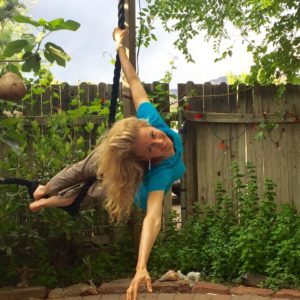I often get asked how to start or sustain a mindfulness practice and what books I recommend. Please read on for some of my favorite FREE mindfulness tips and resources to help you get started.
But first, why should we care?
Let’s say you want to strengthen and tone your body so it is healthier, more flexible and performs better.
You start by reading a few books about getting fit. And you go to some great conferences where they talk about getting fit. Maybe you even listen to some inspiring podcasts. You understand the material and have a mindset and belief in fitness.
All of this might be interesting and informative, but you’ve got to DO SOMETHING differently in order to see a change.
 The same is true for the mind. And reading a book or listening to someone talk (in the traditional sense) does not reshape and rewire the brain.
The same is true for the mind. And reading a book or listening to someone talk (in the traditional sense) does not reshape and rewire the brain.
To see the benefits of mindfulness, you have to actually commit some time regularly to doing the practices.
The good news is that most people start looking forward to their mindfulness practice once they get going and feel a shift in physiology and a sense of empowerment.
We are creatures of habit and hardwired for survival first and foremost. Therefore our primitive fight-or-flight system is very quick to activate, causing us to feel stressed. It takes some time and attention to rewire our brains towards calmness and to shift our emotional setpoint more in the direction of happiness.
But the exciting news is that neuroscience has confirmed that this is possible!
What we do with our mind matters. Our default settings often unwittingly contribute to our suffering.
There can be incredible freedom in making this connection and developing new ways to relate to ourselves and the world.
Some Logistics
I’m often asked about duration of practice and I don’t think there is a correct answer. Research has shown that more is better than less, but I think it’s more important to practice REGULARLY.
If you can only start with 5 minutes a day, do that! Anything is better than nothing, but do it everyday. If you work up to 20 or 30 minutes a day, the magic might start to flow faster.
Build it into your routine, put it in your calendar, do it first thing in the morning, or at lunch. Figure out what will work best for you.
It doesn’t always have to be enjoyable, it just has to happen.
Thanks to technology, there are loads of free resources available to us and they are growing by the day. Most of us listen to guided meditations to get started.
You don’t need any special equipment. Just find a quiet space and a comfortable position (usually sitting, but occasionally lying down as with body scan and maybe loving-kindness). A chair is perfectly fine, you don’t need to be cross-legged on the floor.
Let your family know that you are “working out” or meditating or put a “Do Not Disturb” sign on your door. Simply press play on one of the guided options below, and follow along as best you can. That’s it!
Free Mindfulness Resources
The Free Mindfulness Project has 30 guided mindfulness practices that range in length from 3 to 47 minutes. This could be more than enough information to get you started!
UC San Diego Center for Mindfulness offers dozens of practices of different lengths, and even some videos to go along with their gentle guided yoga.
UCLA Mindfulness Awareness Research Center has 12 meditations of different lengths, including some in Spanish.
Palousie Mindfulness is a free, self-paced version of the popular Mindfulness Based Stress Reduction Program. I don’t think any online mindfulness class is going to be as valuable as an in-person class with a skilled teacher, but if you’re self-motivated and curious, this might be of interest to you. The course takes 8 weeks.
If you want to check out a couple of guided practices that I’ve created, there is a Loving Kindness practice here and a Guided Sitting Meditation here.
Here are some APPS that can support you. I haven’t used Calm or Headspace personally, but have heard good things.
Calm
Headspace
Mindfulness Timer (if/when you want to sit in silence, you can set this timer to gently ring when the time is up; or set it to go off a few times a day to remind you to stop and take some mindful breaths)
Books
While I love reading, I sometimes hesitate to recommend books because if time is limited, it is better to actually practice than to read about practicing. But if you do want to read, my new favorite is called Awakening Joy, 10 Steps That Will Put You on the Road to Real Happiness by James Baraz.
You also can’t go wrong with anything by Thich Nhat Hanh,
Sharon Salzberg
or Tara Brach.
Hey, what’s the science behind all this?
You can find much of the scientific research and articles about mindfulness in the mainstream press at American Mindfulness Research Association.
Some Important Caveats
- Remember that it is the nature of the mind to wander! This is not about clearing the mind or keeping it focused for the entire practice. That is probably never going to happen (it certainly has never happened for me, or for any of the experienced practitioners I’ve spoken with).
- This IS about noticing when the mind has wandered, and very gently and kindly escorting the attention back to the object we are working with (breath, body, sound etc.).
- We do this over and over, and this re-focusing of attention breaks the old, habitual thought patterns that may not be serving us and allows us to spend more time in ways that do not trigger the fight or flight response. This refocusing of attention is what rewires the brain.
- The point isn’t to achieve anything specific, even calmness or peace. The aim is to be with things exactly as they are, noticing and allowing. It is from this open-hearted acceptance that peace often arises but we are not attached to any specific outcome.
- If you experience boredom, frustration, restlessness or resistance, this doesn’t mean that you are doing it wrong, that you’re not “good at it” or that it isn’t valuable. Remember that it is more comfortable to keep doing what is familiar, even if it’s not skillful, so the mind will likely resist and want to pull you into places like planning, worrying, problem-solving or whatever your habitual patterns are.
- We always want to invite an attitude of kindness and curiosity into our practice. It’s not that we will stop thinking harsh thoughts (if that has been our pattern), but we can notice this with kindness, and maybe over time those harsh thoughts will have less of a charge.
- It is a great idea to attend in-person classes/workshops/retreats regularly; or at least virtual classes in real-time.
What are you waiting for?
As the Chinese proverb says:
“The best time to plant a tree is 20 years ago. The second best time is NOW.”
Let us begin (or continue) on the mindful path of clear seeing, deep acceptance and strengthening all of the best qualities within us.
All skillful words and actions to create your best life will flow from this place.
Please let me know how I can best support you! Let me know what you’re curious about or struggling with or want to know more about and I’ll be happy to address it in a future blog or podcast.
If you have any friends who might benefit from this information, please share.
I hope you have a mindful summer filled with many moments of presence, peace and play.
With love,
Erin

A huge thank-you and shout-out to those of you who just spent the week with me in Sedona for the Mindfulness, Magic and Re-Wilding retreat. It was such a privilege to share my red-rock playground and these practices with you all!

Are you on the mailing list yet? Please sign up to get regular inspiration and mindful, magical updates.

 Erin believes that narrow boxes are for shoes and not for people and she hopes you'll join her tribe on the mindful path to freedom!
Erin believes that narrow boxes are for shoes and not for people and she hopes you'll join her tribe on the mindful path to freedom!

